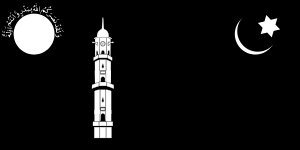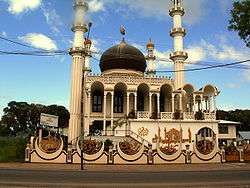Lahore Ahmadiyya Movement for the Propagation of Islam

Ahmadiyya |
|---|
 |
|
Distinct views |
|
|


The Lahore Ahmadiyya Movement for the Propagation of Islam, Ahmadiyya Anjuman Ishaat-i-Islam Lahore (Urdu: احمدیہ انجمنِ اشاعتِ اسلام; Aḥmadiyyah Anjuman-i Ishāʿat-i Islām, Lāhawr) (not to be confused with the Ahmadiyya Muslim Community), also known colloquially as Lahori Ahmadis or Lahoris, formed as a result of ideological and administrative differences[1] within the Ahmadiyya movement, after the demise of Maulana Hakim Noor-ud-Din in 1914, the first Khalifa after its founder, Mirza Ghulam Ahmad.
The Lahoris believe Ahmadiyya founder Mirza Ghulam Ahmad to be the Promised Messiah and Mahdi as well as the Mujaddid (reformer) of the 14th century (AH), but unlike the Ahmadiyya Muslim Community, do not believe him to be a Nabi (prophet) or Rasool (messenger) of Islam, and hold that the use of those terms by Ahmad when referring to himself was metaphorical.[2] Like mainstream Muslims, Lahoris interpret the term Khatam an-Nabiyyin (lit. Seal of Prophets) to mean that Muhammad was the last of the prophets sent by God. Relative to the Ahmadiyya Muslim Community, some mainstream Muslim opinion towards the Lahore Ahmadiyya Movement has been more accepting,[3] with the Lahore Ahmadiyya literature finding easier compatibility with Orthodox Muslims[4][5] and some Orthodox Muslim scholars considering the members of the Lahore Ahmadiyya Movement as Muslims.[6]
According to estimates from the Immigration and Refugee Board of Canada and author Simon Ross Valentine, there are between 5000 and 10,000 Lahori Ahmadis in Pakistan[7] and as many as 30,000 worldwide,[8] making the group much smaller than the Ahmadiyya Muslim Community.
History
The split
The reason for the split was summarised as follows by Maulana Muhammad Ali, the first Head of the Lahore Ahmadiyya Movement, in his English booklet The Split in the Ahmadiyya Movement, published in 1918:
Mirza Bashir-ud-Din Mahmood Ahmad, a son of the founder of the movement, who is the present head of the Qadian section of the community, began to drift away from the basic principles of the Islamic faith about three years after the death of the Promised Messiah, going so far as to declare plainly that the hundreds of millions of Muslims, living in the world, should be no more treated as Muslims. . . . A large number of the educated members of the community, who had the moral courage to dissent openly from the erroneous doctrines taught by him, perceived the great danger to the whole community, when after the death of the late Maulvi Nur-ud-Din a particular clique in the community succeeded in raising M. Mahmud to headship at Qadian without any general consultation. They at once rallied round the true doctrines of the Promised Messiah, and after in vain trying for over a month and a half to keep up the unity of the movement, formed themselves into a separate Society, known as the Ahmadiyya Anjuman Isha‘at-i-Islam, on 2nd May 1914, which is now earnestly working for the propagation of Islam.— The Split in the Ahmadiyya Movement, Preface.
The dispute therefore also involved the issue of whether according to Islamic teachings a prophet can come after Muhammad, as believed by the Qadian section, or if Muhammad was the last prophet after whom no prophet is to arise, as held by the Lahore Ahmadiyya.
Difference in viewpoints
Ahmadiyya Muslim Community
The larger body of Ahmadi Muslims belonging in the Ahmadiyya Muslim Community contend that Mirza Ghulam Ahmad himself received a revelation by God concerning a future split in his Community and that it would be concerning his Promised Son:
God has conveyed to me that there would be a great split in my Movement as well, and mischief makers and those who are the slaves of their own desires will depart... It will be the time of my Promised Son (Mirza Bashir-ud-Din Mahmood Ahmad). God has decreed these events in connection with him... Be sure to recognize the Promised Son.— Tadhkirah pg. 1066-1067
Mirza Bashir-ud-Din Mahmood Ahmad, Second Khalifatul Masih of the Ahmadiyya Muslim Community and the Promised Son in question, also wrote many books regarding the split, including Truth about the Split.
Lahore Ahmadiyya Movement
The Lahore Ahmadiyya Movement believes Mirza Ghulam Ahmad to be the Mujaddid (reformer) of the 14th century Hijra and not a prophet. They assert that, as he himself wrote repeatedly, his use of the terms "Nabi" and "Rasool" was metaphorical, when referring to himself.[2] Members of the movement are often referred to colloquially as Lahori Ahmadis.
Many Muslims do not consider members of the Lahore Ahmadiyya Movement to be Muslims and some group them together with the Ahmadiyya Muslim Community and refer to them by the term "Qadiani" and refer to their belief as "Qadianism", a term rejected by Ahmadi-Muslims as derogatory.[9] Members of the Lahore Ahmadiyya Movement however like to refer to themselves as Lahori Ahmadi Muslims and consider themselves completely separate from the main body of Ahmadis.
As the Lahore Ahmadiyya Movement’s view regarding Mirza Ghulam Ahmad’s status and the concept of finality of prophethood of Muhammad is closer to traditional Islamic thought, the literature published by the Movement has found greater acceptability among the Muslim intelligentsia[10][11] and some orthodox Islamic scholars consider the Lahore Ahmadiyya as Muslims.[12]
The main differing belief that led to the formation of the Lahore Ahmadiyya Movement as a distinct and separate group from the Ahmadiyya Muslim Community is that the Lahore Ahmadiyya believe Muhammad to be the last of the prophets, and that after him no prophet can appear, neither a past one like Jesus, nor a new one.[13] They believe that Mirza Ghulam Ahmad is referred to as a Prophet in the metaphorical sense only (as other Muslims saints have been referred to as well), and not in the real and technical meaning of the word as used in Islamic terminology.[14] In contrast, the Ahmadiyya Muslim Community hold that Muhammad was the last law-bearing prophet but non-law bearing prophets can come after him.[15] They hold Mirza Ghulam Ahmad to be a prophet (with all the qualities of a prophet like Jesus) but subordinate and deputy to Muhammad.[16]
Community locations
Europe
- Great Britain
- In 1913 a mission station was established in Woking (near London) and the Shah Jahan Mosque was maintained by the Lahore Ahmadiyya Movement until the 1960s.[17] The Qur'an was translated into English by Maulana Muhammad Ali.
- Germany
- The Berlin Mosque was built in 1924/27.
- An Arabic-German edition of the Qur'an was prepared by Maulana Sadr-ud-Din
- Netherlands
- Small communities in the Netherlands are located in Amsterdam, The Hague, Rotterdam and Utrecht.[18] On 3 June 2006 Queen Beatrix of the Netherlands visited the Mobarak Mosque to commemorate the building's 50th anniversary.[19]
- Trinidad and Tobago
Demographics
Reliable statistics on the worldwide Lahore Ahmadiyya movement does not exist. However, sources do suggest that in comparison to the Ahmadiyya Muslim Community, the Lahore Ahmadiyya population is relatively very small. In particular, it is estimated that there may be between 5000 and 10,000 Lahori Ahmadis in Pakistan[7] and possibly up to 30,000 worldwide,[8] thereby representing less than 0.1% of worldwide Ahmadiyya population.
Leaders of the Community
- Maulana Muhammad Ali (1874 - 13 October 1951), (Ameer 1914 - 1951)
- Maulana Sadr-ud-Din (c. 1880 - 15 November 1981), (Ameer 1951 - 1981)
- Dr. Saeed Ahmad Khan (1900 - 15 November 1996), (Ameer 1981 - 1996)
- Dr. Asghar Hameed (1919 - 14 October 2002), (Ameer 1996 - 2002)
- Dr. Abdul Karim Saeed Pasha (Current Ameer)
See also
External links
- Official website
- The Lahore Ahmadiyya Movement in Islam
- Lahore Ahmadiyya Islamic Society
- In refutation of 'Qadiani' beliefs
- Differences between the two Ahmadi sects
- Split in the Ahmadiyya Movement by Maulana Muhammad Ali
- 'The Will' by Mirza Ghulam Ahmad with comments by Maulana Muhammad Ali
- Lahore Ahmadiyya Movement Blog
References
- ↑ "Split in the Ahmadiyya Movement", by Maulana Muhammad Ali, 1918
- 1 2 "Hazrat Mirza Ghulam Ahmad Sahib of Qadian never claimed prophethood (in the light of his own writings)", Accusations Answered, The Lahore Ahmadiyya Movement
- ↑ Tributes to Maulana Muhammad Ali and The Lahore Ahmadiyya Movement, AAIIL Website
- ↑ Al-Azhar endorses publications by Lahore Ahmadiyya Movement, AAIIL USA
- ↑ Marmaduke Pickthall's (famous British Muslim and a translator of the Quran into English) comments on Lahore Ahmadiyya Literature, AAIIL USA
- ↑
- 1 2 "Pakistan: Situation of members of the Lahori Ahmadiyya Movement". Immigration and Refugee Board of Canada. 1 March 2006. Retrieved 2010-12-28.
- 1 2 Simon Ross Valentine (2008-10-06). Islam and the Ahmadiyya Jamaʻat: History, Belief, Practice. Columbia University Press. p. 61. ISBN 978-0-231-70094-8.
- ↑ "Lies and the Liar who told them!", Inter-Islam
- ↑ Al-Azhar endorses publications by Lahore Ahmadiyya Movement AAIIL, USA
- ↑ Marmaduke Pickthall's (famous British Muslim and a translator of the Quran into English) comments on Lahore Ahmadiyya Literature AAIIL, USA
- ↑ Tributes to Maulana Muhammad Ali and The Lahore Ahmadiyya Movement AAIIL Website
- ↑ "The Issue of Khatam-un-Nabiyyin", The Lahore Ahmadiyya Movement
- ↑ "The Use of the Terms Nabi & Rasul For Non-prophets", The Lahore Ahmadiyya Movement
- ↑ "The Question of Finality of Prophethood", The Promised Messiah and Mahdi by Dr. Aziz Ahmad Chaudhry, Islam International Publications Limited
- ↑ "A World Reformer", The Promised Mehdi and Messiha, by Dr. Aziz Ahmad Chaudhry, Islam International Publications Limited,
- ↑ http://www.wokingmuslim.org the website of the history of this mission
- ↑ World Wide Branches of Lahore Ahmadiyya Movement
- ↑ The Dutch news in June 2006
